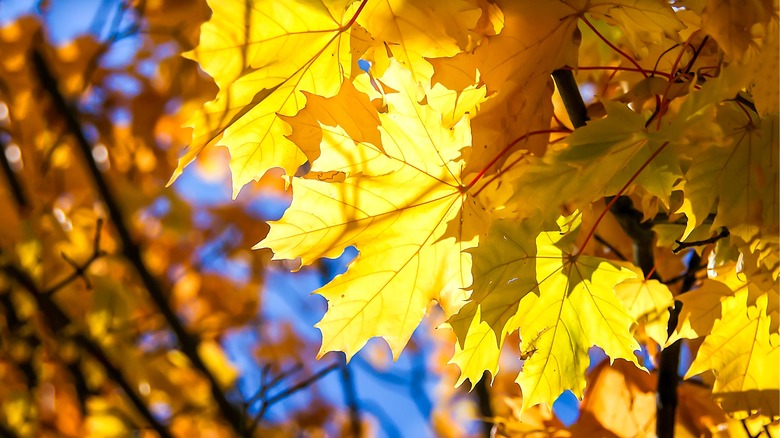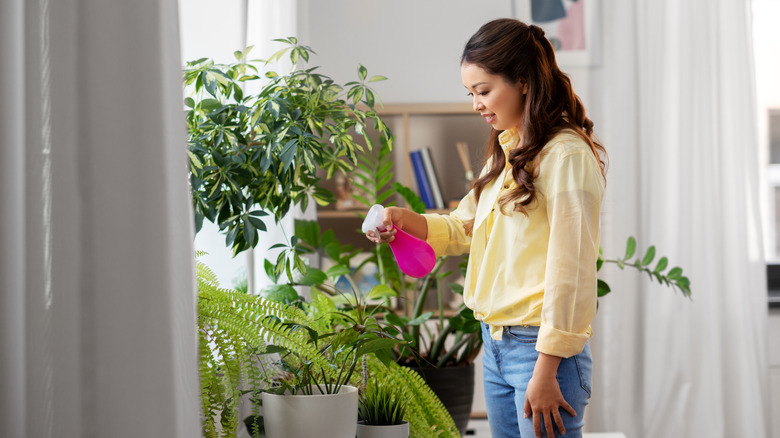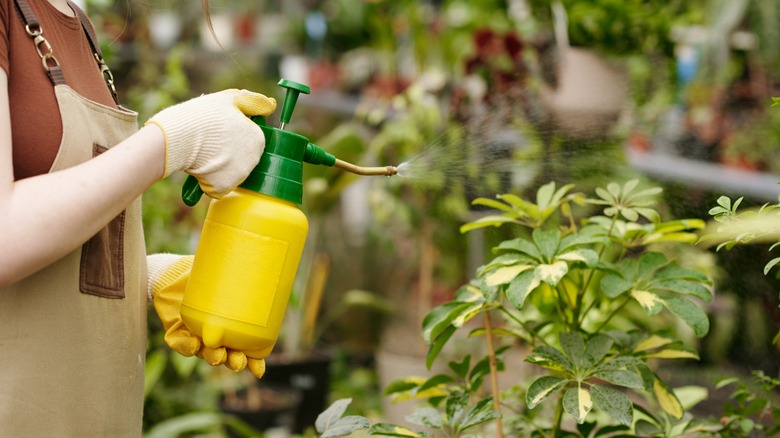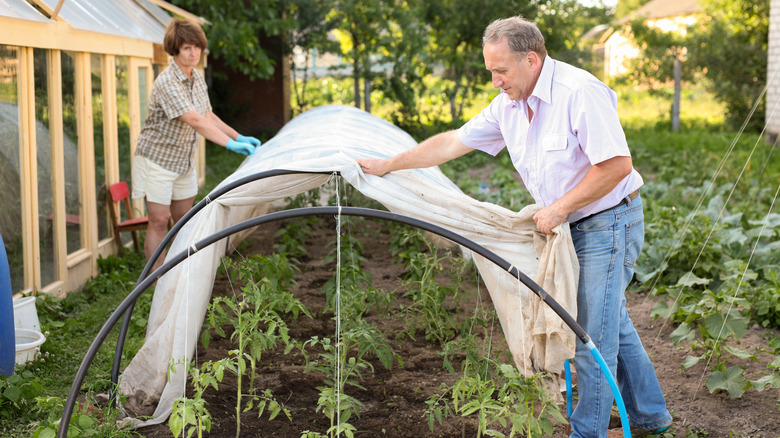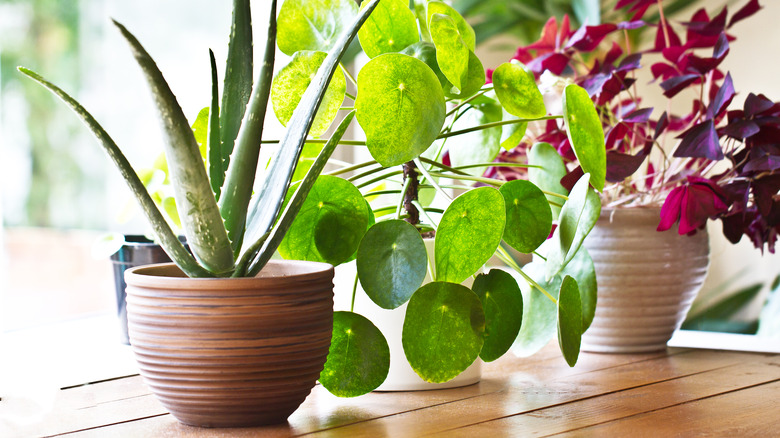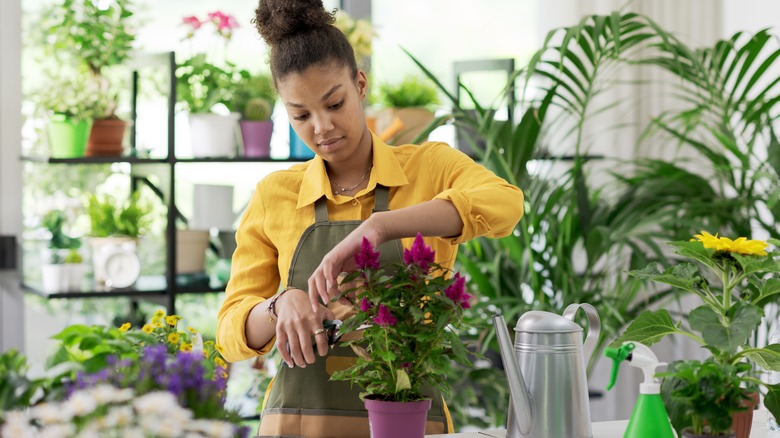Here's How You Should Care For Your Plants In The Fall
Autumn tends to be a beautiful time of year no matter where you live. For many, the leaves change color and the air takes on a crispness as it leaves the summer heat and humidity behind. Even in areas where it remains relatively warm year-round, there is definitely a change to be felt in the atmosphere along with the inundation of pumpkin spice everything and squirrels roaming your garden in a desperate search for nuts to hoard for the winter.
It's not only the humans and the forest animals who feel this change; believe it not, our plants do too — even the ones that live inside. Photoperiodism is defined as "the response to changes in day length that enables plants to adapt to seasonal changes in their environment." According to Yale University News, plants can sense the change in daytime and seasons just as we can, and genetic research on weeds shows this to be true.
So if your plants know fall is on its way, you best be ready to tend to them differently than you did in spring or summer. Whether you live in the cold north, the warm south, or the moderate in between, the onset of autumn signals that a change to your routine plant maintenance is needed.
Put plants on a less frequent watering schedule
As we move from summer into fall, light levels drop as the intensity of the sun decreases. The Institute of Agriculture and Natural Resources at the University of Nebraska-Lincoln explains that with this reduction in light, your plants' water needs simultaneously decrease. This will be especially true for plants you've kept outside over the summer and are just now bringing back indoors, but plants that have remained inside will also feel the effects.
Fall is the time to gradually transition to a less frequent watering schedule. Per the university, overwatering is the top killer of houseplants. We can deduce that this is likely to happen often as winter sets in because, up until then, we're accustomed to drenching them as part of their weekly, if not daily, care. Lawn and garden suppliers at Preen note that we don't want to stop watering altogether, rather wean down our plants from either a daily to a weekly schedule or a weekly to bi-weekly routine. For plants that remain outdoors in the ground, you'll do this until the first frost. For indoor houseplants, you'll water through winter, however, some will only need attention once a month.
Regardless of what specific schedule you land on, the University of Nebraska-Lincoln says to stick with the common wisdom of allowing plants to dry out between waterings and then giving them a thorough soak so that all of the soil becomes evenly moist. Naturally, proper drainage will continue to be very important.
Stop fertilizing
It's easy to make some common mistakes when fertilizing your garden or indoor houseplants, and continuing into fall and winter is one of them. Fertilizer should only be applied when a plant is in an active state of growth (i.e. spring and summer), and many plants go dormant in winter. Since dormancy means flower production ceases and foliage growth slows down or even stops, you'll want to refrain from using fertilizer by the end of summer or the beginning of fall at the latest, explains HGTV.
Illinois Extension says there are benefits to planting outdoor perennials just before the first frost; however, those plants should not be fertilized because, just like the other plants in your garden, they will begin a natural hardening-off process at the onset of colder temperatures. It's okay for the underground roots to keep growing, but increasing nitrogen levels in the soil through fertilizer will instead tell the plant to put its energy into growing vegetation. The end result will be aboveground foliage that cannot withstand the harsh conditions of winter and suffering roots underground that are not receiving their rightful dose of the plant's natural energy reserves.
The same is true for houseplants, confirms Savvy Gardening. By mid-August, you can halve your regular doses and increase the time between feedings, so that by the time you've entered winter, you have ceased applying any fertilizer. Savvy Gardening also notes that continuing to fertilize at this time could cause chemical burns and leaf damage.
Decide if plants will come inside or stay outside
You love your plants, and a good way to prove your devotion is to figure out how to best protect them from the freezing temperatures and harsher elements that come with winter weather. By mid-autumn, your plants will be comfortable with their decreased water and fertilizer schedules, and it'll be time to take the next step in fall care. Get Busy Gardening explains that this is the time to bring your more delicate plants indoors. To minimize the shock of their rehoming, do this before it gets very cold, while the temperatures outside are still similar to the temperatures in your house.
Some growers, especially those with extensive vegetable gardens, may be looking to extend their harvest season for as long as possible. Garden Therapy offers some hot tips for doing just that, including using frost covers at night and removing them during the day, mulching the base of your plants to keep them warm, and installing hoop houses or cold frames. For flowers in container baskets, simply bringing them inside overnight and re-hanging them outside in the morning can lengthen their bloom time.
Winterizing your outdoor plants with wraps and ground covers should not happen until after temperatures have gone (and stayed) below freezing, warns Backyard Boss. For now, you can focus on putting together your plan and collecting your supplies, whether those will be burlap sacks, landscape fabric, or even old bed linens and tablecloths (via Lawn Starter).
Provide indoor plants with more light
There's no question that the light changes in the fall. Plant care bloggers at La Résidence explain that the changing tilt of the Earth is responsible for longer shadows and a more diffused/less intense dose of sunlight come the end of September. While plants require less water in the darker months, they still love and need light. Hence, most of them appreciate being moved to a brighter spot in the house.
The University of Minnesota Extension makes a strong case for giving your plants access to more sunlight in the fall, noting that without sufficient light plants are unable to produce the chlorophyll they need to keep their leaves healthy and green. Low light can also cause houseplants to become leggy, meaning their stems grow skinny and weak as they stretch upwards in search of the sun.
If the windows of your home do not receive enough direct sunlight, of if you simply have more plants than can fit in the area (trust us when we say, we're right there with you!), there are different types of grow lights you can install to improve the situation. The University of Minnesota says to pay close attention to the colors and intensities of the bulbs you choose. Package directions or a local professional should be able to help you figure out how far away from your plants they should be situated and for how long you should keep them on each day.
Prune, but only for clean up of dead leaves and decay
Clean, disinfected, dry, and sharp. Before beginning any pruning maintenance, this is the condition you want your cutting shears to be in. Per the Good Earth Plant Company, a simple application of rubbing alcohol will go a long way to prevent the spread of disease from contaminated cutters and your happy houseplants.
When you're set up and ready to prune, start slowly and concentrate on dead and decaying leaves. If you have a plant with an excessive amount of yellow foliage, Good Earth Plant Company recommends figuring out if there's an underlying problem. A few discolored leaves are par for the course, but a stem full may be pointing to a lack of sufficient sunlight, too much watering, or a more serious problem.
In the fall, it's fine to use pruning to shape your plants to a minimum degree, however, Get Busy Gardening notes that over-pruning will trigger new growth similar to the way fertilizer does. Since new growth is not something you're looking to encourage at the end of the year, it's important to go light on the shaping. The real point of this exercise in the autumn months is to clean up your plants so they can go into a full resting state over the winter without being put at risk of becoming a haven for pests, mold spores, and fungi, all of which can cause infections that lead to disease.
